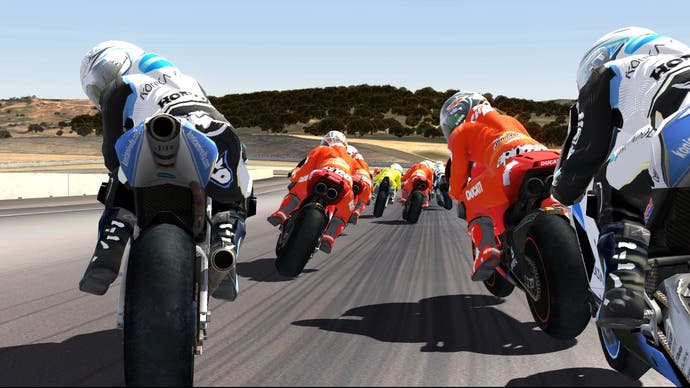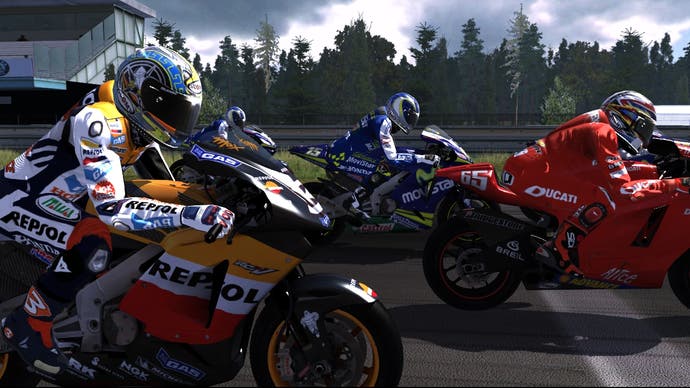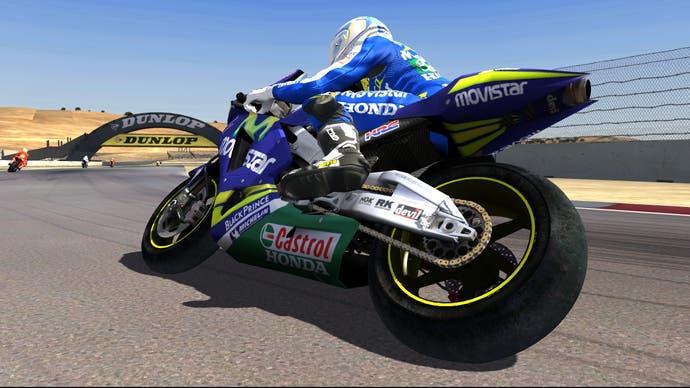MotoGP 2006
Sharp turn.
Motorbike games don't always get a fair hearing in the games press. There are people around here (me included) who'd jump up and down or at the very least offer counterarguments if somebody claimed Pro Evolution Soccer was just the same game every year, but MotoGP? Now, I'd imagine the standard of games journalists' health and habits has improved substantially over the past few years, but there aren't many obvious bike nuts, despite the potential for sitting down in a hunched position straining to see things zooming past us very quickly.
Anyway, the long and short of that is, when I told people I was off to Woking to see the new MotoGP, the general response was, "I hear that has motorbikes in it," and "I saw that. It looks prettier. Um." It certainly does look prettier! Let's get into that.
Maybe think of MotoGP Ultimate Racing Technology 3, which came out on Xbox last year, as a JPEG. JPEG's a lossy compression format that allows big pictures to occupy by less disk space by doing complicated things that involve splitting the image into squares and tracking colour changes. They are obviously what the image was, but if you look closely you can tell where they're cheating. MotoGP 2006 is pretty close to being the TGA standard of motorbike racing games, lossless in its appreciation of the mechanics of a bike. Whereas Xbox bikes looked like bikes and behaved mostly like bikes, Climax reckons the GP '06 models are absolute replicas, designed to spec and designed to behave to spec - right down to the way that light bounces off the latticework of carbon fibre on a rear mudguard, using several of the 360's shaders at once as if for kicks. So yeah, it's "prettier", but that's like telling a photographer that you like his new camera because it's "shiny". You both know it's more than that, but the difference is something that only he really gets. Well, bike fans get this stuff.

Publisher THQ estimates that GP '06 has about five times the detail of URT 3, but that's a meaningless stat - the real proof is in looking at the bikes. We already know that the braking systems are independent, for example, so the game knows what's meant to happen to the bike in the world when you press the rear brake button, but when you brake in the 360 version the bits of the bike that would normally act, act. The detail's so fine that you can make out the weld marks, and if you stripped things down you could even see where the artists put the serial numbers on the parts. To the right extent, this detail extends to the rider too - I doubt Climax got Valentino Rossi to pose naked for them, but when he twists one of the handlebars, it's not just an awkward, disjointed wrist movement; you can see the right muscles flexing.
The only approximations here are down to things that were physically impossible to do. For example, they weren't allowed to actually have Rossi's bike, so working out his unmuffled exhaust noise was a question of likeness. Rather than just make something up though, they took a street bike, put it in a shipping container and took the can off the exhaust and recorded that. THQ reps claim the bikes are now so detailed that they managed to confuse one of the manufacturers, who reacted to a pitlane shot Photoshopped to include a GP '06 model by demanding to know where they got a photo of the new bike. "We didn't, that's ours!" said Climax, beaming. "No it isn't." "Yes it is." So the story goes.
This stuff matters to Climax. It would have to, given they've done nothing but make bike games for more than half a decade, and it infuses them with attention to detail. For example, the bikes have all sorts of sonic characteristics most people wouldn't bother with. You can even hear popping when you change down through gears. Each bike's audio is modelled individually, and the 360 also allowed the team to play with multiple channel inputs, so that when your Ducati's roaring through a turn and a Honda sweeps alongside, you can appreciate the deeper bass of the other bike's engine noise. So could the folks a mile away from the recording area, apparently, which led to some police involvement.

The world that the bikes inhabit is understandably less detailed - dreams of modelling real sand and real spectators down to the ticking of the wrist-watches they check as bikes zoom past are still the stuff of science-fiction - but that's not to say Climax hasn't worked hard at the environment. All of the official Dorna tracks are included - which means three new ones for GP '06 - and the designs and in-game realisation were based on topographical info. The idea is to have no sense of loading, no pop-up, no fogging; wherever you look, the game allows you to see what you'd be able to see, whether that's vegetation, tarmac further along or, in Laguna Seca, for example, anything within a particular square kilometre of California that might be in sight. A lot of this is owed to the dev's Tomcat middleware, which allows them to do things and then experience them in-game without having to sit around waiting for a build.
Actually having everything in the game world all the time creates an interesting situation where Climax applies techniques we traditionally associate with calculated occlusion - like fog to obscure pop-up happening further down the road - in an entirely meteorological sense. Speeding along the highway next to the sea, there's a whiting effect from the spray kicked up by the waves, which means certain details come into sharper focus as you close in on them. They're not hiding anything; it's just what you're meant to see. In terms of lighting, the team's tried to model things like refraction effects on the way the human eye works.
All of which, long-winded runthrough of the stuff I managed to jot down out of the way, is well and good. But this isn't a picture we're painting; it's a game. Thankfully it plays like it looks and sounds: as though the people making it really cared. As you race around you can feel the attention to detail in the way the rumble changes as you slide over different surfaces. As you come round for a second lap, you can see where the pack laid down rubber in the run-up to the first corner to help you telegraph where to turn; each track surface is made up of several layers, and it's persistent enough to keep track of scorch marks when you come round again.

What's always impressed about MotoGP, even when it was on Xbox 1, was how naturally it seemed to lend itself to a learning curve. The problem was that those first stumbling steps were really quite difficult. After that, you'd stop just using left trigger for both brakes and right for acceleration and use the individual brake controls; you'd use the left stick to hunch or lean back in the saddle rather than simply steering; you'd switch to having dual analogue turning control in corners so that you could counterbalance a turn by leaning the other way. The 360 hardware can pontificate on that sort of detail with much less sweat than the Xbox 1, and the learning curve here is slightly gentler in general. And there really is something to be said for riding a motorbike in a game; you can tell so much more about what's going to happen than you can in a car. Plus, the first-person view over the handlebars is fantastic. People wax on about Project Gotham Racing 3's in-car view; I found this far more appealing. The step up to 360 is something even the "well, it's prettier" crowd will get immediately.
Anyway, I mentioned highway earlier - one of the main additions to URT3 was Extreme mode, which allowed you to drive around circuits shaped from the areas surrounding the official racetracks on street bikes in jeans. Apparently the idea came when Climax went to Valencia for a GP and thousands of bikers descended on the town, and police even closed off streets so they could donut the pavement and generally show off. It's a kind of bike culture extension, and the bikes here have all been modelled to the same degree of detail as their GP equivalents - if not more so, since one of the advantages of using relatively everyday bikes is that Climax could gain physical access to them.
Extreme mode is a confusing name though, because it's actually a bit gentler than the GPs. Roads in real life aren't full of hairpins and chicanes, so instead you tend to coast along deliberately wider highways in tracks designed by the team, based on approximations of the real life road systems. There are three more this time, modelled on areas surrounding the three new Dorna tracks.

That addition of three tracks raises another point - whereas URT3 had full 2004 MotoGP season data, GP06 has complete 2005 data and will have 2006 data. The 2006 season hasn't actually happened yet; the idea is that when you play the 06 season, the game will download info from races completed and that will affect your starting grids and outcome, the only variable being where you place. In theory, you could watch the GPs and then play out your own races and slot in, the data seamlessly downloaded from Live.
Another consideration in GP '06 was the recurrence of what Climax calls "embedded gameplay", where you gain experience online that seeds you, so that when you log on to play with people on Live the game pairs you with riders of equivalent skill - measured by laptimes and wins. As you become more proficient, it'll put you up a class, and if you're obviously flagging it'll rank you down. It doesn't technically bother with this offline, but as with recent MotoGP games GP '06 is always online anyway, so it's a moot point. And, of course, GP '06 has 16-player support for a full grid.
The code we saw in Woking was apparently 8-12 weeks from code-complete - only a few of the tracks were really playable and we didn't get to properly appreciate the weather effects and other minor details like finalised particle effects. Even in this state, the attention to detail is striking. What's particularly admirable though is that MotoGP 2006, to a greater extent than its predecessors, seems to understand how what they're emulating can be structured to fit the requisite arcs and thrills of a game. That probably sounds like fluff, so think of it this way: relatively few people in this country play ice hockey or golf, but we've got ice hockey and golf games that map the actions of those sports to fit a rewarding structure, distilling key disciplines like a chip shot swing into a passable analogue reproduction. MotoGP looks to be doing that, and it doesn't need any flaming balls or arcade aftertouch to do so. If it ramps up to the stuff we've seen in a way that works for people who haven't even seen a MotoGP game before, it should be one of the 360's best early racers. Plus, of course, it's prettier.
MotoGP 2006 is due out on Xbox 360 sometime this year, release date TBC.

